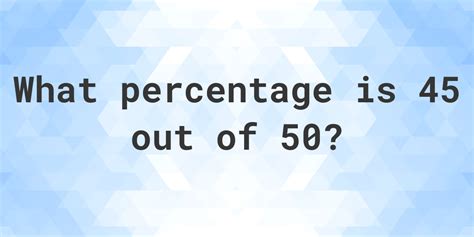What Is 45/50 As A Percent
Kalali
Mar 31, 2025 · 4 min read

Table of Contents
What is 45/50 as a Percent? A Comprehensive Guide
Converting fractions to percentages is a fundamental skill in mathematics with widespread applications in various fields, from calculating grades and discounts to understanding financial data and statistical analyses. This comprehensive guide will not only show you how to calculate 45/50 as a percentage but also delve deeper into the underlying concepts, providing you with a solid understanding of fraction-to-percentage conversions and offering practical examples.
Understanding Fractions and Percentages
Before we dive into the specifics of converting 45/50, let's refresh our understanding of fractions and percentages.
What is a Fraction?
A fraction represents a part of a whole. It's expressed as a ratio of two numbers: the numerator (top number) and the denominator (bottom number). The numerator indicates the number of parts you have, while the denominator indicates the total number of parts the whole is divided into. For instance, in the fraction 45/50, 45 is the numerator and 50 is the denominator.
What is a Percentage?
A percentage is a way of expressing a number as a fraction of 100. The symbol "%" is used to denote a percentage. Percentages are widely used because they provide a standardized way to compare different fractions or proportions. For example, 50% means 50 out of 100, or 50/100.
Calculating 45/50 as a Percentage: The Steps
There are several ways to convert 45/50 into a percentage. Let's explore the most common methods:
Method 1: Converting the Fraction to a Decimal
This is arguably the most straightforward method. To convert a fraction to a percentage, first convert it to a decimal by dividing the numerator by the denominator:
-
Divide: 45 ÷ 50 = 0.9
-
Multiply by 100: 0.9 x 100 = 90
-
Add the Percentage Symbol: 90%
Therefore, 45/50 is equal to 90%.
Method 2: Finding an Equivalent Fraction with a Denominator of 100
This method involves finding an equivalent fraction where the denominator is 100. This directly gives you the percentage because percentages are based on a denominator of 100.
-
Find the Multiplier: To change the denominator from 50 to 100, you need to multiply it by 2 (50 x 2 = 100).
-
Multiply Both Numerator and Denominator: Since you multiplied the denominator by 2, you must also multiply the numerator by 2 to maintain the fraction's value: 45 x 2 = 90.
-
Express as a Percentage: The equivalent fraction is 90/100, which is equal to 90%.
This method highlights the fundamental relationship between fractions and percentages. Any fraction can be converted to a percentage by finding its equivalent fraction with a denominator of 100.
Method 3: Using Cross-Multiplication
This method is particularly useful when dealing with more complex fractions. It involves setting up a proportion and solving for the unknown percentage.
-
Set up a Proportion: We can set up a proportion like this: 45/50 = x/100, where 'x' represents the percentage we're trying to find.
-
Cross-Multiply: Cross-multiply the terms: 45 x 100 = 50 x x
-
Solve for x: This gives us 4500 = 50x. Dividing both sides by 50, we get x = 90.
-
Express as a Percentage: Therefore, x = 90%.
Practical Applications of Percentage Conversions
The ability to convert fractions to percentages is incredibly useful in numerous real-world scenarios:
1. Academic Performance:
Imagine you answered 45 out of 50 questions correctly on a test. Converting 45/50 to 90% instantly tells you your test score, making it easy to understand your performance and compare it to others.
2. Financial Calculations:
Percentages are fundamental in finance. For example, calculating interest rates, discounts, tax rates, and profit margins all rely on converting fractions to percentages. If a store offers a 10% discount on a $50 item, you'd calculate the discount as (10/100) x $50 = $5.
3. Data Analysis and Statistics:
In data analysis and statistics, percentages are used to express proportions and probabilities. Converting fractions to percentages allows for easier comparison and interpretation of data. For instance, if 45 out of 50 people surveyed prefer a particular product, this can be expressed as 90% preference.
4. Everyday Life:
Percentages appear in countless everyday situations, from understanding sales tax to calculating tips in restaurants. Being able to quickly convert fractions to percentages simplifies these everyday calculations.
Beyond 45/50: Mastering Fraction-to-Percentage Conversions
While we've focused on 45/50, the methods discussed are applicable to any fraction. To master fraction-to-percentage conversions, practice with various fractions, gradually increasing their complexity. Consider working through examples with different numerators and denominators, including those with larger numbers or decimals.
Here are some additional examples to practice:
- What is 20/25 as a percentage? (Solution: 80%)
- What is 3/4 as a percentage? (Solution: 75%)
- What is 15/60 as a percentage? (Solution: 25%)
Conclusion: The Importance of Percentage Conversions
Converting fractions to percentages is a critical skill with broad applications across various aspects of life. Understanding the underlying principles and mastering the different methods discussed in this guide will significantly improve your ability to handle numerical data efficiently and effectively. Remember to practice regularly to solidify your understanding and increase your confidence in tackling any fraction-to-percentage conversion problem. This skill, once mastered, will become an invaluable tool in your mathematical arsenal.
Latest Posts
Latest Posts
-
6 Out Of 10 As A Grade
Apr 02, 2025
-
Scatter Plots And Line Of Best Fit
Apr 02, 2025
-
What Is The Percent Of 7 12
Apr 02, 2025
-
30 To The Power Of 2
Apr 02, 2025
-
What Is 400 Fahrenheit In Centigrade
Apr 02, 2025
Related Post
Thank you for visiting our website which covers about What Is 45/50 As A Percent . We hope the information provided has been useful to you. Feel free to contact us if you have any questions or need further assistance. See you next time and don't miss to bookmark.
